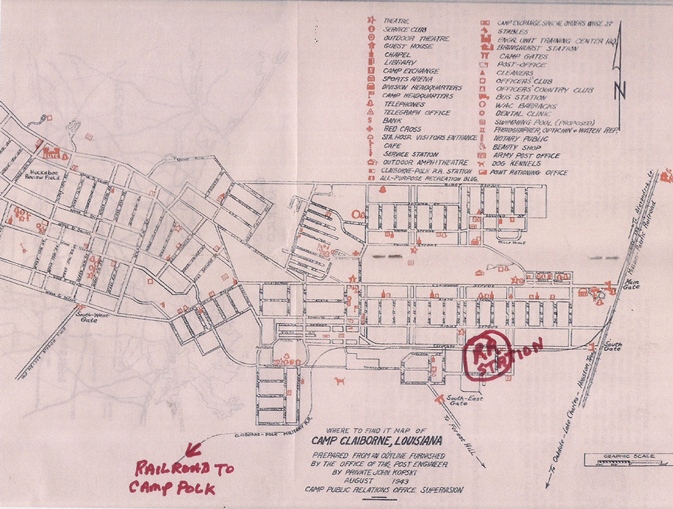REMEMBERING THE CLAIBORNE-POLK RAILROAD
BY RICKEY ROBERTSON
Throughout West Central Louisiana during the heyday of the large sawmill towns, rail lines crisscrossed the area. We remember the Red River and Gulf, the Christie and Eastern and other rail lines operated by the timber companies. And today we still see the old tram lines throughout the timberlands of our area. But did you know that during World War II Louisiana had a different type of railroad in operation? This was the military railroad known as the Claiborne-Polk Railroad.
Camp Claiborne was the US Army's largest army base during World War II and units of every type trained here, from infantry, armor, engineer, signal corps, to supply units. Over 500,000 troops trained at Camp Claiborne during World War II. But Camp Claiborne became the training base for a different type of military unit too. Camp Claiborne was the location where many of the Railroad Operating Battalions in the US Army were trained. Construction on Camp Claiborne began on September 3, 1940 and by December 1940 the 34th Infantry Division began to arrive to a camp comprised of 6,796 tents and 684 frame buildings. By 1942 this massive camp was filled with wooden buildings and barracks that replaced the tents. And one of the largest areas of this base was the massive railroad yard.
The US Army saw the upcoming need for Railroad Operating Units to run military railroads wherever they would be needed in the event of war. Camp Claiborne was chosen to train these units and to build and maintain a rail line. On June 18, 1941 the 711th Railway Operating Battalion was activated at Ft. Belvoir, Virginia and was made up of experienced railroad men who came from railroads across America to form this unit. This was the first railway operating unit activated and in service since the end of World War I. On August 18, 1941 the 711th arrived at their new home, Camp Claiborne, La. As their equipment arrived and the right of way was surveyed out the 711th began to work on what was to be known as the Claiborne-Polk Railroad. This rail line ran forty-eight miles and operated between Camp Claiborne and Camp Polk. The 711th was helped as they built this rail line by the all black 91st and 93rd Engineer Battalions. Some of the tram lines ran along the old rail bed of the Hillyer-Deutsch-Edwards Lumber Company from Glenmora to near LaCamp. But one major obstacle stood in the way of the rail line. The obstacle was the Calcasieu River. The Calcasieu River and the swamp around it posed a great problem, due to the unstable mud and sediment and the problem of overflows by the raging river. But the men of the 711th, and the 91st and 93rd began to bridge the river, often working up to their waists in mud and water. But they accomplished the mighty job. A bridge 2,126 feet long was completed. This was some kind of engineering feat!
By February 25, 1942 the line was over completed for over five miles out of Camp Claiborne and by July 10, 1942 the line had reached near LaCamp and units that had begun laying the east bound line at Camp Polk met up with the units coming westward from Camp Claiborne. The massive rail line was completed. On July 11, 1942 all the units gathered near this site to have a special ceremony where the last "golden spike" would be driven. Brigadier General Carl Gray Jr., head of the Military Railway Service, had the privilege to drive the last spike. And would you believe, he missed on his first two attempts to drive the spike! But the spike was driven in and the Claiborne-Polk Railway began full operations on September 20, 1942. Each day two passenger trains operated in each direction along with one freight train each day but Sunday. At one time there were ten engines working out of the Claiborne Rail Yard. But for the 711th and other Railway Operating Battalions the work was not over. There were many derailments, many near the Calcasieu Bridge, and the units would race to see how fast they could clear up the derailment. They set up the derailed cars, rebuilt the tram bed, re-railed the location and got the railroad operating again. And also to help train these units, planes from nearby Alexandria Air Base, DeRidder Air Base, and Pollock Air Base attacked and bombed the rail line. The railway units would rush to rebuild the damage and would get the line operating in short time. This was some type of tough training wasn't it!
As the Allies began to push the Axis enemies back on all battlefronts, our Soviet Allies needed trucks and equipment of all types. The 711th Railway Operating Battalion at Camp Claiborne was sent overseas and they operated the Trans-Iranian Railway where trains filled with American equipment and vehicles were shipped to locations where Soviet units picked them up to be used in their fight against the Germans and their allies.
Today there is nothing left of the Claiborne-Polk Railroad or the massive Calcasieu River Bridge. All we have left is memories of this military railroad. But I have been to the site of old Camp Claiborne many times and have walked the location of the old rail yard and have walked down stretches of the Claiborne-Polk Railroad. The old tram bed is still visible throughout the area and you may even find an old railroad spike. We don't hear the whistle of the trains coming from the massive rail yard at Camp Claiborne anymore….but we sure have the memories of this railroad where railway units learned how to build and maintain military railroads across the world. And these railroads helped our nation to win victory in World War II.
.jpg)
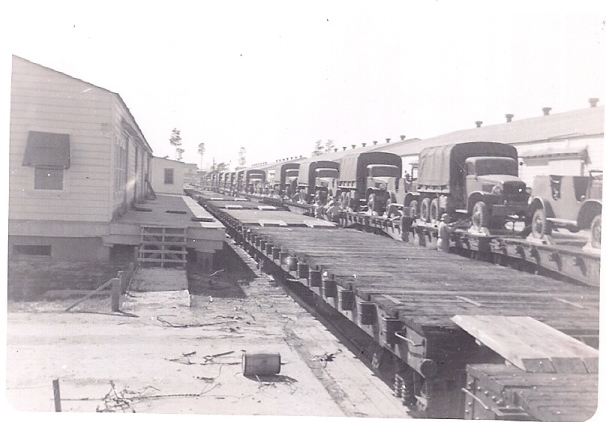
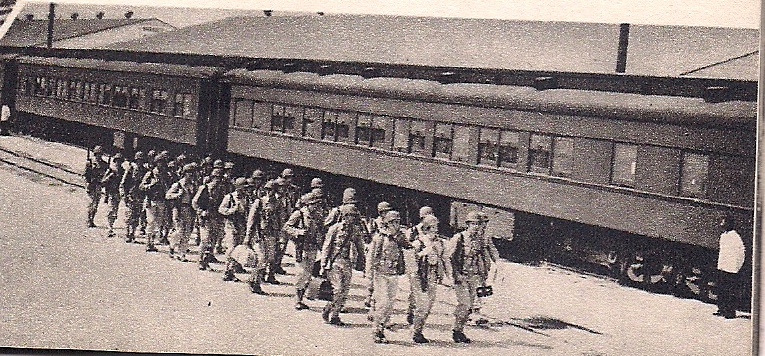
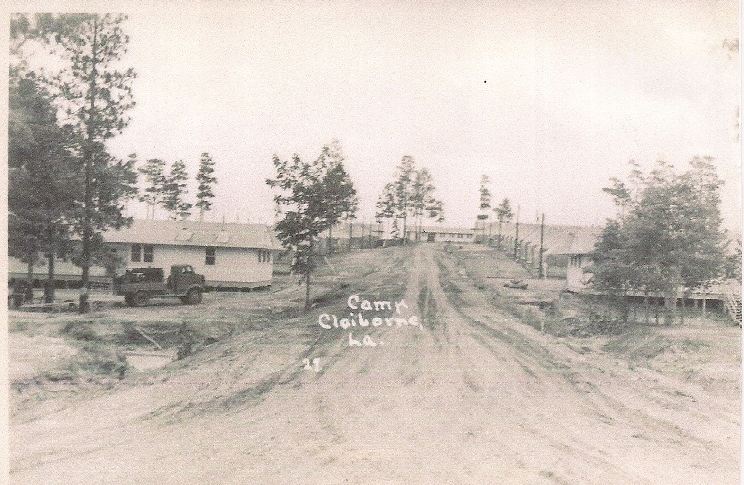
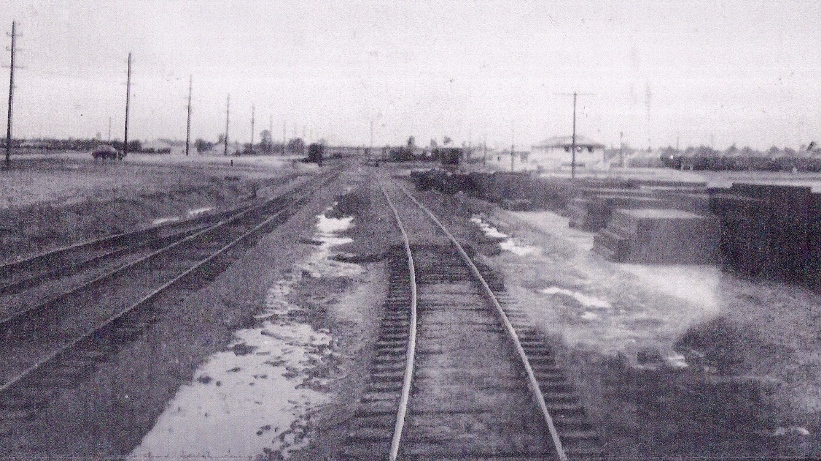
Looking out of the rail yard at Camp Claiborne westward down the Claiborne-Polk Railroad toward Camp Polk. (Robertson Collection)
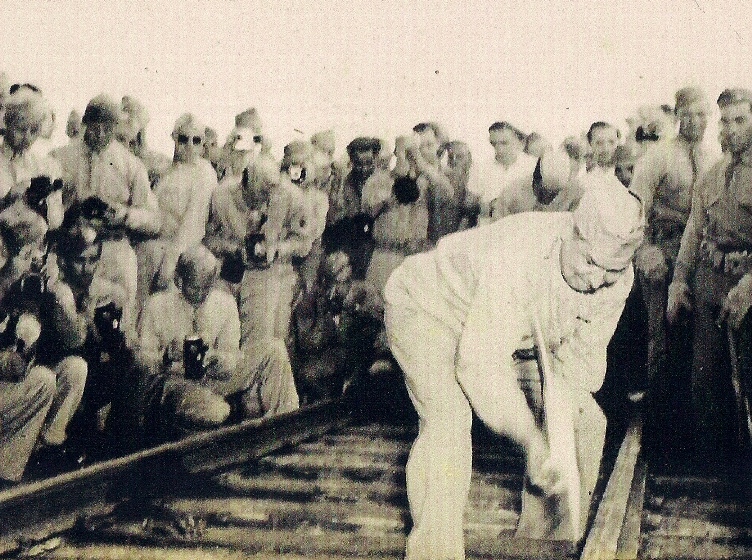
Brigadier General Gray drives the "golden spike" upon completion of the Claiborne=Polk Railroad. (Robertson Collection)
